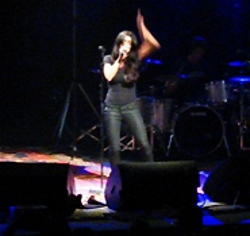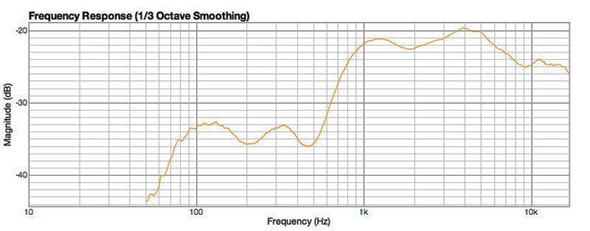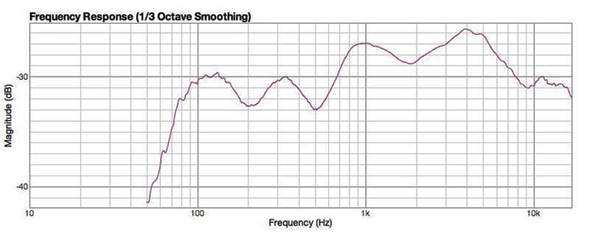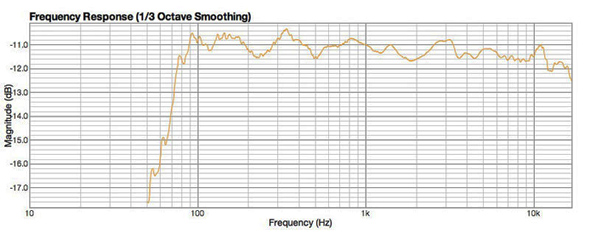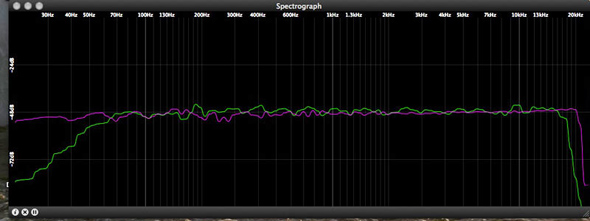A while back, I was having a discussion about the sound quality of our monitors with our sax player.
He’s a very discriminating guy who really knows sound. If he says he needs 185 cut 3 dB, he needs 185 cut at 3 dB.
As we listened to his wedge, it was clear that the sound he was putting out of his horn was not being faithfully reproduced by the wedge. I knew it would take a while to remedy this, but I set aside a day to go through and fix the wedges.
First off, here is our signal chain: Each mic gets plugged into a splitter (it’s passive, not transformer isolated, which was a bad choice, but not mine). One split goes to a Yamaha M7CL console in monitor world. The M7 mixes up to seven wedge mixes.
The omni outs of the M7 go to two Klark-Technik 9848 4 x 8 processors set up in 4 x-Biamp mode. The KTs feed a rack of QSC amps, which in turn feed EAW SM12 monitors. Aside from the split, it’s a decent system.
It took me a little bit, but I finally got my Mac talking to the 9848s (using Parallels, XP and a RS232-USB converter). I should mention that KT’s tech support was very helpful and quick in getting this running. Once I had that going, I had a nice, graphical interface with which to adjust the settings.
I positioned a wedge in the middle of the stage, and placed our Earthworks M-30 measurement mic right about where a musician would stand.
I took the following approach: When EQ’ing monitors, you really aren’t worried much about the room as it’s really a near-field monitor. The only real boundary is the stage itself, and my goal was a pretty linear system; that is, flat and set up so that what goes into the board comes out of the monitors.
In the past, I would have started running pink noise through the system and looking at the response on an RTA. But that amount of noise (I measured at 94 dB SPL-A) gets annoying really fast.
I’ve been learning more about more modern forms of measurement including swept tone and FFT, so that’s how I went about this process. I’ve found swept tone gets me a lot closer a lot faster than pink noise, without the grating noise.
I started off with a great little program I found called FuzzMeasure Pro 3 (from SuperMegaUltraGroovy Software, the best software company name ever). FuzzMeasure uses swept sine wave deconvolution to report frequency response.
If that sounds complicated, don’t worry. All you need to do is hook the mic up to a USB interface and press measure. The software emits a quick click that is used for impulse measurements (great for setting delay, but that’s another post), then a swept sine wave from 20 Hz to 20 KHz (or in my case, 50-17K; it’s user-adjustable).
The resultant frequency response is shown on a graph. Here’s where we stared.
Keep in mind that each light grid line is 1 dB. So we started off with the low end some 13 dB below the mid- and upper-range; not so good. I made a 12 dB adjustment on the gain for the low channel (actually I cut 6 off the top and added 6 to the low).
Now we start getting a little closer. But it’s still way off. After spending some time with the PEQs built into the KTs, I ended up with a sweep that looked like this:
It might look a bit wonky, but realize that this time, the heavy grid lines are 1 dB. So the response could be called flat, ±1 dB from 80 Hz-17 KHz (the right edge of the graph is 17 KHz, as set in my prefs)—that’s not too shabby.
Now, because I was getting more complaints from some musicians that others, I decided to drag another wedge over and take a measurement. I was surprised (well, not that surprised) to see a significantly different trace, even with the same EQ settings as the first one.
So I decided to tune each monitor individually. In my new setup, each monitor has a number, and it will always be used with the matching monitor send.
Thus, Speaker 1 will be plugged into Monitor 1 on the patch panel. This ensures that all monitor mixes are basically the same, even though production variations give each wedge a slightly different response curve. I’ve applied custom EQ to each one.
The final step was to tweak it a little closer using another cool program called Spectre from Audiofile Engineering. Spectre has a a compare trace FFT function which allows you to look at the signal coming out of the board and the signal coming back from the measurement mic at the same time.
With some gentle pushing and pulling of the EQ curves, I was able to get that line almost completely flat. It’s a little easier to see in this view, where the purple is the output of the M7 pink noise generator and the green is what’s coming back from the measurement mic (which is nearly completely flat from 20-20K).
What’s fun about this view is that if you add say, a 8 dB bump at 1K on the output EQ of the monitor mix, both curves show exactly 8 dB of bump, in a bell curve that looks just like the graphic on the EQ display. I had now reached the point of it being a linear system; what goes in comes out.
The next weekend, I asked our sax player how his wedge sounded. Without telling him what I had done, he commented, “Oh, it sounds much better. Very musical and pretty much exactly what I expect to hear.” Mission accomplished.
Mike Sessler has been involved with church sound and live production for than 25 years, and is the author of the Church Tech Arts blog. Based in Nashville, he serves as project lead for CCI Solutions, which provides design-build production solutions for churches and other facilities.


